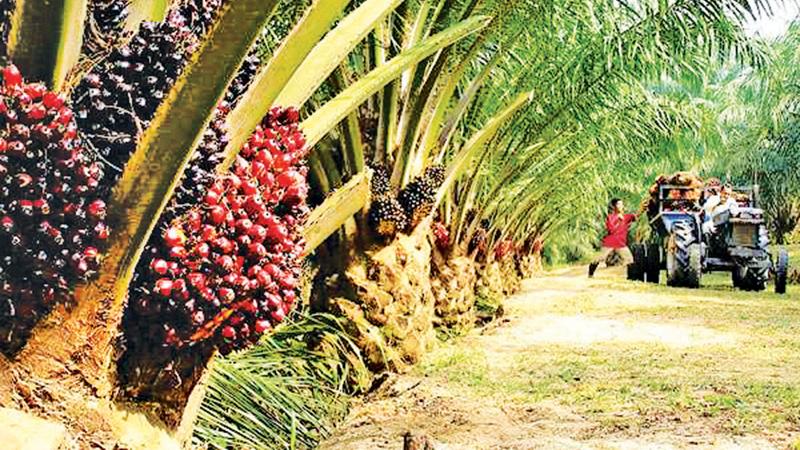
Countering claims by promoters of oil palm cultivation that it has no adverse impact on the environment, in depth research reveals that there are several social and environmental impacts of this perennial crop.
Senior lecturer Faculty of Agriculture, University of Peradeniya Dr. Lasantha K. Weerasinghe said although in-depth research on oil palm cultivation and its social and environmental impacts have not been reported locally, several long term research studies done elsewhere in the world where oil palm cultivation is done on a commercial scale reveals certain negative impacts of the cultivation on the environment and on Society.
However, he said the expansion of oil palm cultivation in Sri Lanka has raised serious concerns regarding its environmental and social impacts particularly the reduction of bio-diversity, the depletion of water sources, loss of long term soil health and issues related to unplanned disposal of mill effluents.
“Being a perennial tree crop, oil palm at least from the seventh or eighth year onwards produce a continuous and dense canopy cover which cut down penetration of sun light into the ground layer casting heavy shade on the ground making conditions unsuitable for light loving crops to be grown leading to the reduction in the number of floral species naturally found in that environment,” Dr. Weerasinghe said, adding that intercropping does not become a viable option when compared to coconut plantations.
He said, rats are found to be one of the most serious pests of oil palm at all stages of development hence increased rat population has been associated with oil palm plantations.
“Oil palm exhibits faster growth rate and production of higher biomass and yield when compared to rubber and coconut. In order to support production of higher biomass and yield, nutrients that are removed continuously through the harvested fresh fruit bunches (FFB) or sequestered in the standing biomass needs to be replenished via application of fertiliser/nutrients to the soil,” Dr. Weerasinghe said.
A Review performed in 2002 by the Sri Lanka Association of the Advancement of Science (SLAAS) has revealed that Fertilizer use /requirement of oil palms, is 8-10 times more exhibiting 10 times more nutrient outflow as compared to rubber plantations which could negatively impact on long term soil health questioning the sustainability of the system. Extensive use of pesticides/herbicides in oil palm plantations could be washed off into waterways with the rain and contaminate water sources.
During processing, for every ton of palm oil extracted, approximately 1-2 tons of effluent is produced. Letting the decomposition of matter in the effluent take place while keeping the effluent in ponds is vital before the discharge of the effluent to the outside environment - something which does not always happen in Sri Lanka.
Evapotranspiration data reveals that water loss via single oil palm tree is approximately 400 litres per day which is greater when compared to Evapotranspiration of coconut and rubber. In order to have a larger net carbon gain to support the production, an adult oil palm tree maintains larger total leaf area (400 m²) in the canopy when compared total leaf area of the canopy of an adult coconut palm (130–150 m2) and an adult rubber tree, thus the larger total leaf area could also lead to three times higher evapotranspiration ratio than in oil palm. Such higher water loss could lead to a water deficit soil environment in plantations.
“The conversion of natural forests for oil palm plantations is associated with the loss of biodiversity, including a decline in populations of iconic species,” Dr Weerasinghe said.
A position paper on ‘Oil palm Expansion in Sri Lanka’ by the Centre for Environmental Justice (CEJ) also shows that oil palm cultivation has a number of negative impacts.
The study reveals that unlike Malaysia and Indonesia where oil palm is responsible for massive forest destruction, Sri Lanka doesn’t have forests for oil palm cultivation. The remaining forests are very critical and they are mostly under the Forest and Wildlife Departments. Even the remaining lands under the Land Reform Commission are very critical wildlife habitats and are on the slopes. Plantations started uprooting rubber and planting oil palm in Matara, Galle, Kalutara, Kegalle and Rathnapura districts, as rubber has turned out to be uneconomic.
The Presidential Secretariat has tasked the Coconut Research Institute to promote oil palm in Sri Lanka. They have developed the guidelines to promote oil palm in Kalutara, Rathnapura and Kegalle District. However, there is no monitoring of the implementation of these guidelines.
The current government has decided to plant 20,000 Ha in the Kegalla district.
This decision erupted public protests in that area.
According to the research, oil palm plantations degrade water quality (Journal of Geophysical Research: Biogeosciences). It found that streams flowing through oil palm plantations were hotter, dirtier and consumed more oxygen compared to other areas.
Presenting a study on the crop, planters claimed that environmental concerns are mere myths.
“I cannot simply understand the logic behind stopping the cultivation of palm oil when there are clear guidelines issued by the government with regard to the extent of the cultivation. Tea, rubber and coconut are no longer lucrative crops,” a planter said.
